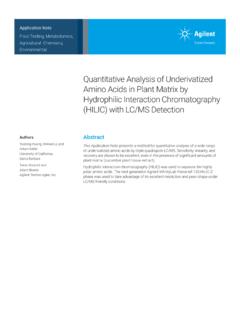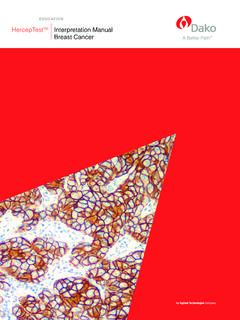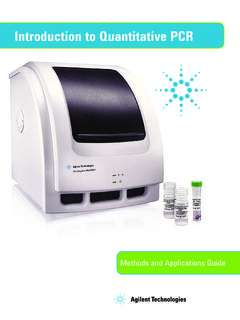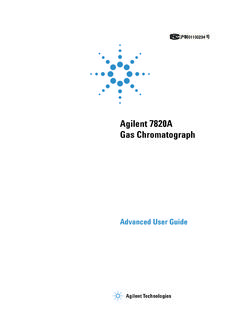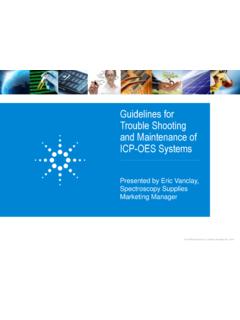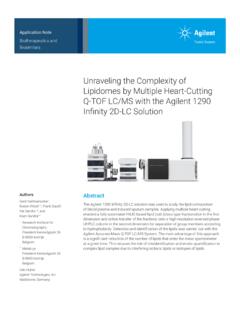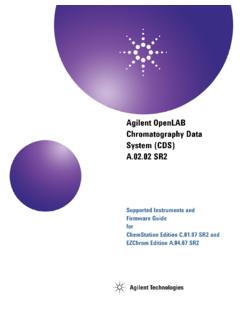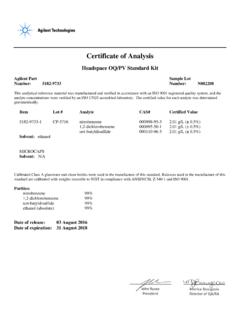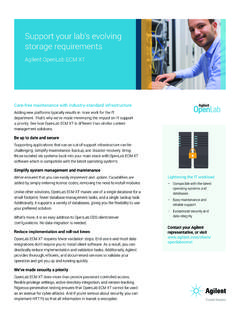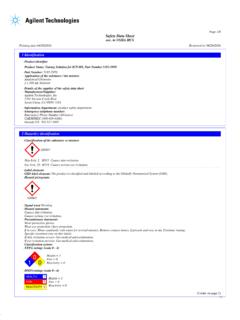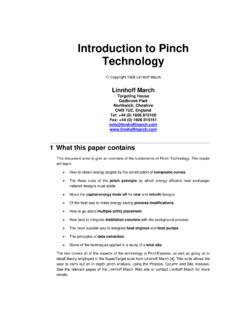Transcription of Analysis of C1 to C10 Hydrocarbons Including C1 to C6 ...
1 Analysis of C1 to C10 HydrocarbonsIncluding C1 to C6 Paraffin/OlefinIsomer Separation at Ambient Temperature Using Dual FID and aCapillary Flow Technology DeansSwitchAuthorsKelly Beard and Shannon ColemanAgilent Technologies, NoteExtended Hydrocarbon AnalyzerAbstractA gas chromatography method has been developed for the Analysis of C1 C10 Hydrocarbons on a single injection, without cryogenic cooling, using a CapillaryFlow Technology (CFT) Deans Switch. This application note describes a method forthe high resolution Analysis of C1 C6 paraffin and olefins, as well as an extendedhydrocarbon Analysis in both gas phase and liquid phase samples. 2 IntroductionFor the Analysis of samples with a large boiling point range,nonpolar capillary columns that separate Hydrocarbons byboiling point characteristics are typically used.
2 Boiling pointcolumns provide good resolution for the heavier hydrocarbonfraction. However, the resolution of the light hydrocarbon frac-tion suffers when C1 to C4 Hydrocarbons are present in highconcentrations. Boiling point columns are also not thecolumns of choice for the separation of C4/C5 olefins. PLOT columns provide enhanced separation for the light hydrocar-bon fraction, but they exhibit recovery issues for the heavierfractions, making the Analysis of the heavies difficult. A solu-tion to this problem is to configure a CFT Deans Switch with aboiling point and a PLOT column. The boiling point columnprovides resolution for the heavy hydrocarbon fraction and thePLOT column provides resolution for the light hydrocarbonfraction. For this Analysis , an Agilent 7890A Gas Chromatograph wasfitted with a 4-port liquid sample valve, in series with a 6-portgas sample valve, a split/splitless inlet, and a CFT DeansSwitch, configured with a DB-1 (123-106B) and HP-PLOT Q(19091P-QO4PT) column.
3 The DB-1 was configured as the pri-mary column and the HP-PLOT Q was configured as the sec-ondary column with a short restrictor column opposite thesecondary column, to balance the Deans Switch. In the Offposition, the effluence of the DB-1 column was directed to theshort fixed restrictor directly to the Back FID, while theHP-PLOT Q column carrier gas flow was delivered by theDeans Switch. When the Deans Switch was switched to ON,the effluence of the DB-1 column was directed through theHP-PLOT Q column to the front FID, while the fixed restrictorcarrier gas flow was delivered by the Deans Switch (Figure 1).This configuration allowed for a Heart Cut of the light fractiononto the HP-PLOT Q column for additional are three ways to introduce samples with this configuration: Directly from a heated gas sample cylinder or directly fromprocess through a gas sample valve Directly from a piston style pressurized liquid sample cylinder through a liquid sample valve Syringe injection directly into the GC inletThis configuration allows for simultaneous separation of allcomponents, while eliminating the possibility of contamina-tion and adsorption of heavies, on the HP-PLOT Q column.
4 Application This specific application required the measurement of C1through C10 in ethylene and propylene to 1 ppm. Resolution oflow-level ethane and propane as well as heavy hydrocarbonsis required in less than 20 minutes. If water is not present andhigh resolution is required for C4 and C5 olefins, theHP-PLOT Q column could be substituted with an AluminaPLOT column. For this application, C1 C5 were selected to beanalyzed on the HP-PLOT Q column and C6 and above wasselected to be analyzed on the DB-1 column. The DeansSwitch heart cut time was set by injection of a C1 to C6straight chain gas phase paraffin standard with the DeansSwitch off, to establish retention time on the DB-1 column. Figure 1. Deans CAPBackFront FIDFIDDB-1DB-1 Fixed restrictorFixed restrictorHP-PLOT QHP-PLOT QNONCAux EPCAUX 231 Deans Switch - Off Deans Switch - On Front CAPBackFront FIDFIDCOMCOMNONCAux EPCAUX 2313 Results and DiscussionFigure 1 shows the results from the Analysis of the paraffinstandard with the Deans Switch in the Off position, bypassingthe HP-PLOT Q column.
5 This is necessary to set the cut timesto the PLOT column. In this case, the cut times were set to3 minutes and minutes, as depicted in Figure 2. Figure 3 and Figure 4 show the results from the Analysis whenthe heart cut times are incorporated into the method. As thelight fraction C1 C5 components elute from the DB-1 column,they are heart cut to the HP-PLOT Q column. These compounds are then further separated on the HP-PLOT Q, anddetected by an FID as shown in Figure 3. After the heart cut ismade, the remaining components, C6 and up, elute throughthe restrictor to the second FID, bypassing the HP-PLOT Qcolumn (Figure 4).Figure 2. DB-1 3. HP-PLOT Q column C1 through C5 4. DB-1 column extended Switch onDeans Switch offEthanePropaneButanePentaneHexane54678 9pA1008060402008 Hexane HexeneEthybenzenem,p-xyleneo-xyleneBenze neTolueneNapthalene1,3,5 TMB1,2,4 shall not be liable for errors contained herein or for incidental or consequentialdamages in connection with the furnishing, performance, or use of this , descriptions, and specifications in this publication are subject to changewithout notice.
6 Agilent Technologies, Inc., 2013 Printed in the USAS eptember 27, 20135991-3253 ENConclusionUsing a Capillary Flow Technology Deans Switch configuredwith a Dual FID provides an effective way to analyze a verybroad spectrum of compounds with different retention char-acteristics. Both polar and nonpolar Analysis can benefitusing this technique. This approach provides a fast, flexibleanalysis with easy setup, without the need for cryogenic cooling for both gas and liquid phase samples. For More InformationThese data represent typical results. For more information onour products and services, visit our Web site
